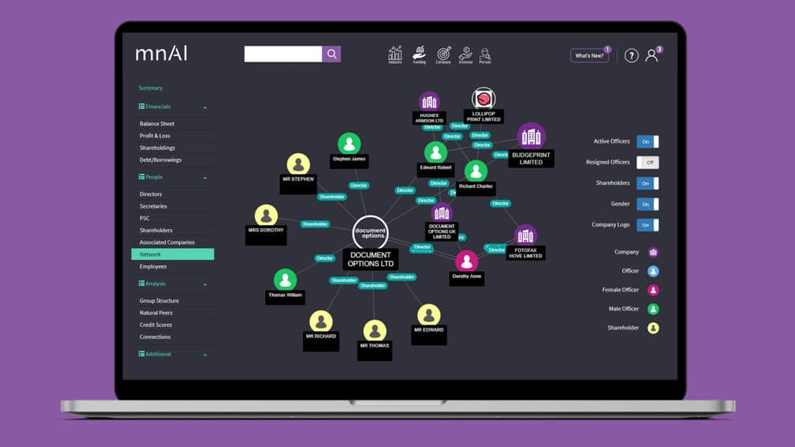02 Sep 2021
How data can be used to strengthen lead generation and generate new business

Historically, lead generation used to mainly consist of purchasing lists of names, with sales representatives cold-calling or sending out mailshots. However, modern advances in technology and data collection and management have dramatically changed the buying journey and made it possible for companies to generate leads based on specific criteria and information. Collecting and analysing data gives us the potential for far more accurate and fruitful lead generation activities.
Today’s customers have a huge amount of information available to them, largely through digital channels including search engines and social media. Well before they make a decision to buy, or even engage with a potential supplier of the product or service that meets their needs, they are able to thoroughly research their options.
This means that they are less likely to be prepared to engage with any sort of sales pitch that doesn’t meet their needs.
So while modern marketing technology now makes it possible to collect far more detailed information about potential buyers, using data as a marketing lead generation tool, the flip side of that is that you then need to tailor your marketing communications far more accurately to their specific needs, or risk losing their interest.
In this article, we’re going to talk about how data can make lead generation more effective, and look at 4 different ways data can be used with lead generation tools to make your sales cycle more efficient.
4 ways data can be used to strengthen lead generation
1. Audience segmentation
Data is an essential market research tool, allowing you to hone in on the segmentation of your audience groups and strengthen your lead generation campaigns.
Segmentation of your target market allows you to target the right content to the right people, in the right way for them, rather than delivering ‘blanket’ campaigns. Segmenting your campaigns can improve lead generation by enabling you to develop more tailored marketing messages to meet the needs of each audience. Using data to segment your target audience also allows you to choose not just what content you deliver, but how, when and where, making it more probable that your campaign will find people in the right place and at the right time.
Data can be used in lead generation to segment the audience by identifying people who meet certain criteria – age, gender, behaviours and interests etc – and deliver marketing campaigns tailored to them, making your lead generation more effective and more targeted.
Audiences can be segmented in a number of key ways. Below we will look briefly at the four main types of audience segmentation. It’s important to remember that with the right lead generation software you can create even more niche groups within each broad segment.
Demographic Segmentation
One of the most basic and common approaches, which segments audiences based on observable, people-based differences; things like age, gender, marital status, occupation, education level, income, race, nationality and religion.
Geographic segmentation
Geographic segmentation is exactly what it sounds like, dividing your market based on their location – country, region or postcode. Knowing a customer’s location can help you better understand their needs, the likelihood of their buying from you, and enable you to send out location-specific marketing communications.
But you can also segment consumers based on the characteristics of their location, such as its climate, the population density or whether the area is urban or rural. Again, understanding their location can help you if you need to target individuals or businesses in a specific area or with a particular need.
Behavioural Segmentation
Another way to segment your audience is through analysing data that tells you about their behaviours – like their online shopping habits. Gathering and analysing data about the way people use online shopping can help you to design an experience that meets their needs and makes it more likely that they will make a purchase from your site. Data analysis makes it possible for you to track actions on your website – how long do they stay? Do they read information and articles to the end? What kind of content do they click on?
Behavioural data is particularly useful because it relates directly to how a customer or potential customer interacts with your brand. This insight can help you market more effectively to them.
Psychographic Segmentation
Psychographic segmentation deals with characteristics that are more mental and emotional, like personality traits, interests, beliefs, values, attitudes or lifestyles. Understanding them can help you to create content that is more appealing to your audience.
While demographics provide the basic facts about WHO your audience is, psychographics give you insights into WHY people decide to purchase from you (or not) or interact with or ignore your content.
2. Use data to understand a business and its key people
A helpful way of using data to strengthen lead generation when you’re marketing to a business is to use it to understand more about the company – beyond simply its industry, sector or location.
Historically, there have been few ways to gather and analyse deep-dive data and company insights without time-consuming manual research.
Our platform can be used to strengthen lead generation by providing almost instantaneous data sets which provide company insights including:
key people of influence with the company and its wider networks
master directorship records, which to help uncover all businesses related to one key individual
employee lists and contact details to enable you to reach out to prospects

3. Use internal data to test, analyse and adjust campaigns
Your internal data can be essential in improving lead generation. Carefully gathered and analysed, your own data, gathered through data collection and analytics tools such as Google analytics or your own CRM system, can be used to a/b test the results of different campaigns, and improve your results for better lead generation.
Access to insight from your website analytics and CRM data can drive improvements in your marketing messages, the customer experience on your website, and how and where your marketing materials are delivered.
You can also use a/b testing to generate additional internal data that will help you to improve your lead generation.
Modern marketing software enables a/b testing, allowing you to test consumer preferences and generate data that can be used to make informed, data-driven decisions when structuring and designing your marketing campaigns. You can test varied messages, platforms and formats on your audience segments, gathering data on your potential leads’ preferences before launching a final campaign. This allows you to target customers more efficiently and improve conversion and lead generation goals.
A/B Testing enables you to:
- Compare two versions of advert, landing page or article content, showing you which generates the most engagement and allowing you to improve the final version before launching the main campaign
- Test two forms of information to see which generates the most conversion so that you can adjust and refine for future campaigns
- Test lead pages and funnels for low-end products or services in order to refine for high-end products or services
4. Use data and insights to better understand your customers and your market
Gathering data for market research will help you to identify business opportunities; and using it to understand who you need to reach out to, what they are interested in and their preferred channels will strengthen your lead generation activities.
Regular market research is also a way of keeping in touch with your current customers and potential customers to ensure that you’re still meeting their needs. Testing new designs and products on a small subset of your audience before launching can help to avoid expensive mistakes. Finding out why customers aren’t repeat buying, or why repeat sales are dropping off will help you to identify problem areas – whether the issue is with the product or service no longer meeting customer needs, or your customer experience or after-sales service is at fault.
Thorough market research will reveal what content you need to use on your social media accounts, and campaign materials to show your customers how you are meeting their needs.
Using data to underpin your market research can help to strengthen your lead generation through:
- revealing a segment of your market that your competitors have neglected, and that you could target
- giving you a clearer picture of the actual size of your potential market
- showing you where and how to allocate your marketing budget
- confirming whether or not there is a demand for a new product or service you plan to introduce
- giving insights into your pricing strategy.
Why do so many companies skimp on their market research?
The problem with market research is that a lot of companies, particularly those with a small marketing team, don’t have the time or resources to undertake the extensive market research needed to fully understand their markets. Or, with the pace of change accelerating, they don’t have the resources to do it regularly and check in with the up-to-date picture.
It’s understandable. When a team is launching a new product or service, there’s often a lot of pressure to make progress, and get it out there. Spending hours, days or weeks on market research isn’t a popular choice!
The good news is that there is a comprehensive data platform which you can add to your kit of marketing tools to help you with fast, in-depth market research.
How mnAI’s data can help to strengthen your lead generation activity
The most comprehensive source of UK company data, our uniquely accessible insight and analysis across industries, sectors and geographies is a vital marketing tool. Our AI-based platform revolutionises data gathering by taking the manual research element out of market research. It provides instant access to filtered data and analysis across sectors, companies, geographic areas and individuals, delivered through a simple to use and easy to interpret dashboard. It even allows you to search by gender – enabling you to target female business owners, in a particular sector for example.
mnAI can provide the information needed to segment your market by demographic variables such as age, gender, and location, helping you to swiftly identify companies that may meet a marketing campaign’s objective and provide new leads. Unique market maps can be used to identify which industries are popping up, and where, allowing you to spot potential new markets.
The detailed information available even allows you to create visual networks of shareholders, directors and companies, and to view balance sheets and P&L reports as well as debtor and creditor networks, so you can exactly what position a company is in – ideal if you are marketing to businesses in early growth stages, for example.
With access to all mnAI’s data, marketing teams and company directors can seek out prospects quickly and easily (as well as filtering out those that aren’t right). That means more targeted networking, marketing and lead generation, cutting down on wasted effort and making success more likely.
With billions of data points (and 100m+ added every week) everything up to date and allows real-time insights, ideal for fast-moving marketing campaigns.
mnAI’s sophisticated search ability includes over 350 search variables, allowing quick and easy targeting of companies that meet precise criteria. Search results are produced in moments and are presented in a simple to use dashboard. This level of customisation can save hundreds of hours of manual market research.


